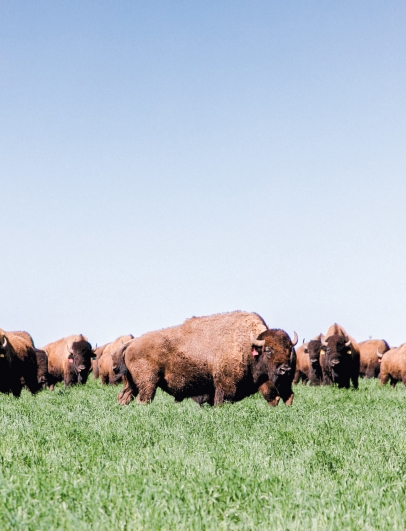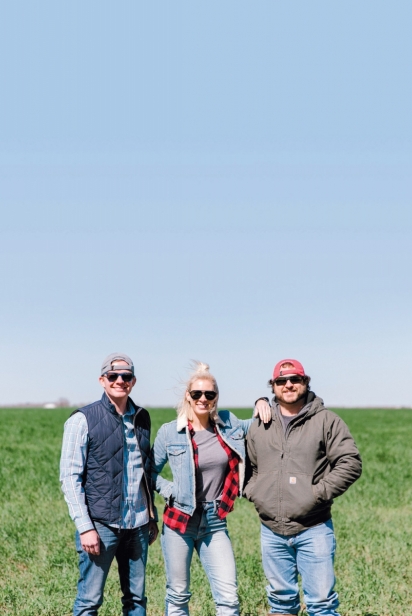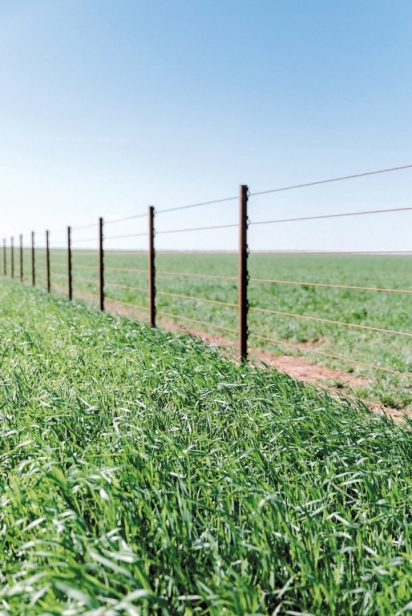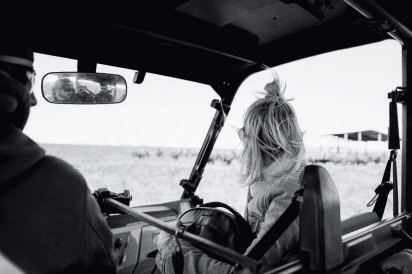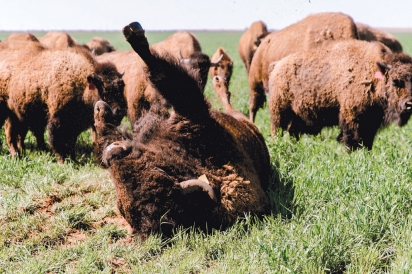Benjamin Lee Bison - A State of Transition
Benjamin Lee Bison Helps Lead the Transition to Sustainable and Regenerative Agriculture in Oklahoma
Sayre is a two hour drive west from Oklahoma City on I-40, past Clinton and Elk City, through previously uninterrupted grass prairie and what is now a patchwork of farms, ranches, and hulking turbines stretching 380 feet into the endless sky. A walk across this land includes a rarely interrupted breeze and ground peppered with Devil’s Claw seed pods, reminiscent of a small horned skull, historically used in basket weaving by the indigenous peoples of the southwest. In the 1930s, Sayre was on the edge of the Dust Bowl’s worst drought and soil erosion.
It’s here you can find Austin Lee Puckett, Jessi Deardorf, and Kyle Benjamin Reynolds working on their new project, Benjamin Lee Bison. Consisting of 2,000 acres and almost 800 bison, their land has been in Austin’s family, the same family who started community staple Puckett’s Food Store, for over four generations and was partly acquired from friendly neighbors and family friends. Their three core values: social responsibility, transparency, and quality.
When it comes to their operations, Austin, a co-founder with Kyle, will be the first to give it to you straight. “When [we] raise bison, what that really means is we grow grass. Healthy grass is gonna make healthy bison,” he extolls. “Our goals of being completely regenerative means you don’t have to spray any pesticides and you don’t have to use any chemical fertilizer.” For Austin, Jessi, and Kyle, this means alternating between bermuda grass in the warm months and winter rye. Both grow so dense that, unless it's overgrazed, the grass crowds out weeds. More importantly, bison love it. Not to be confused with their distant African and Asian cousins the buffalo, bison are native to North America and once grazed over the plains by the tens of millions until excessive hunting and development reduced their numbers to less than a thousand in 1900. Today, they number over 360,000.
The Challenge
Benjamin Lee Bison exists at the nexus of two forces careening towards each other. The United States’ farming and ranching industry began large-scale management of heavily subsidized crops or livestock fueled by pesticide, fertilizer, and till-reliant practices to meet the growing demands of early-mid twentieth century America. This is now known as conventional farming. Common crops grown conventionally have shallow root systems which cannot effectively deliver carbon nutrients converted from atmospheric CO2 by photosynthesis to soil microorganisms deep underground. Without a diverse set of soil microorganisms, plants can’t get the nutrients they need. Depleting the land’s carbon nutrients makes farming more difficult and more expensive with each season. Combined with the global increase in human produced CO2 output, most scientists and observers expect an increase in our climate’s variability, bringing more intense and dangerous climate phenomena and living conditions for species around the world.
Based on natural cycles of growth with grazing animals and indigenuous practices, regenerative and sustainable agricultural practices address both of these issues. Where conventional agriculture views soil as a growing medium to be amended, regenerative agriculture views soil and animal management as the foundational and self-sustaining mechanism for producing safe and nutritious food and addressing the glut of CO2 in our atmosphere. Regenerative agriculture’s focus on animal grazing, cover crops, and crop rotation without tilling not only improves soil health by using grass’s natural deep root system, but has the potential of removing roughly 23 gigatons of atmospheric CO2.
The Transition
Among the forces at work in this agricultural and cultural transition, education and experience for farmers and ranchers are key. Inertia is a pivotal force. As Kyle describes it, many chose conventional ranching because “it's the way we’ve always done it. Austin and I aren’t afraid to do a bunch of research whether it's online, finding a forum on Reddit, or reaching out to a university.”
One of the most common questions asked of the BLB team is simply, why? Why would you do that? “The whole thing just seems bizarre to people,” says Austin.
For farmers and ranchers experiencing perennially tight times, making a shift, even if it may ultimately make financial sense and benefit our ecosystem, can be difficult. Chelsey Simpson of local and organic focused grocery store Urban Agrarian and former Communications Director of the National Young Farmers Association understands the challenges at work. “We’d like to see our local food system grow and hopefully in a way that can sustain and support the ecosystems we have. But, there’s not only weather issues or soil issues, there’s a learning curve.”
Even though farmers who use organic and regenerative practices can get a higher price for their goods at farmers markets and stores like Urban Agrarian, the transition can seem daunting at first. Oklahoma educational and research institutions including the Noble Research Institute and Kerr Center for Sustainable Agriculture are there to help ranchers, farmers, and families alike through on the ground research and training. In March 2021, Noble Research Center refocused all operations towards developing regenerative agricultural practices in Oklahoma and nationwide. Steve Rhines, President and CEO of Noble, views Noble’s role as key to helping farmers and ranchers understand how to incorporate regenerative practices on their specific land. “It’s moving from what you know or are comfortable with to a different operational model. One of our targets is to focus on the objective, science based evidence...and put it in a form that a 25 year old or 80 year old farmer or rancher can gain access to.”
David Redhage, President and CEO of the Kerr Center, sees a similar issue. In addition to educating the producer, consumers need to understand the items in their cart. “There is a value to food and its nutrients. Are we as consumers willing to pay for quality?” In the end, “farmers and ranchers want to leave the land in better shape than when they got it...but it’s also about finding a market and consumers’ willingness to pay for those products.”
Treating the land and the bison well means benefits beyond the ethical. Under factory farming and ranching, consumers have become reliant on cheap, subsidized goods with lower nutrient content. Grass fed bison produce meat that is lean and high in protein, iron, omega-3 and omega-9 fatty acids, which have beneficial effects for energy, cholesterol levels, and general heart health. Buying local, organic, and grass fed goods requires both access and ability to prioritize personal spending towards high quality and nutrient rich food. Kelsey at Urban Agrarian sees the growing demand and is working to provide the supply. “We’re not only interested in [farmers] being local but being as sustainable as they can be. That means a lot of different things to different people, but we’re looking for people who use humane animal treatment practices and sustainable practices with their soil and their water.”
For Austin, Jessi, and Kyle, their focus is on the care of their family’s land and its animals. Jessi, who manages marketing and works on the ranch, frequently refers to the bison by name or by their relationships. “How big is Clay? Is that 311? 284 and 272 are his best friends.”
For Austin, the dedication to the bison’s wellbeing seems personal. “If you really do care about where these animals come from and the lives they live, we’ll take the Pepsi challenge against anyone. You want to come out and see what it looks like? We’ve got land we’ve put into grass and land we just cleaned up and it’ll be two years from grass. If that really matters to you....I’d love to hear your thoughts on it. There’s somebody here that will have a conversation with you about it.”
While bison are a key to their work, the BLB team also looks to the future and its myriad opportunities. As they continue to acquire and return property to grassland, they see tours, educational seminars, and ranch to table dinners on the horizon. “We want to be hands-on with building the sustainable and regenerative system that bison create naturally.” In Oklahoma’s long arc from dustbowl to regeneration, building on the earth’s natural cycles and choosing grass fed meat at the grocery store are keys to making the world a little better for us all.
> Benjamin Lee Bison: 18851 E 1210 Rd, Sayre; buysomebison.com/ You can order their bison in various cuts for delivery through their website or find it at the Paseo Farmers Market, Scissortail Farmers Market, the Market at Common Place, or through Urban Agrarian.
> Urban Agrarian: 1235 SW 2nd St., Oklahoma City; 1 E. Main St., Edmond; urbanagrarian.com
> Kerr Center for Sustainable Agriculture: 24456 Kerr Road, Poteau; kerrcenter.com
> Noble Research Institute: 2510 Sam Noble Parkway, Ardmore; noble.org


